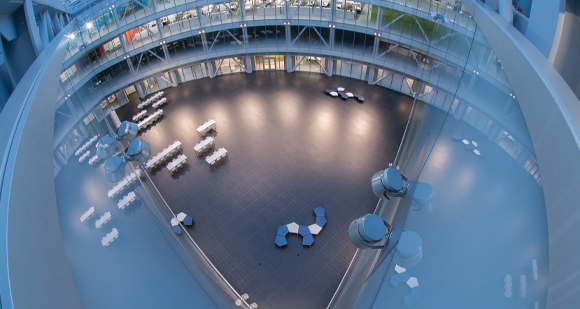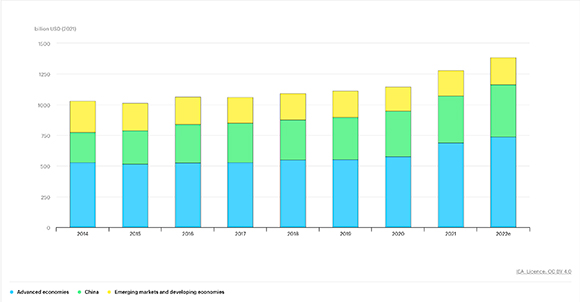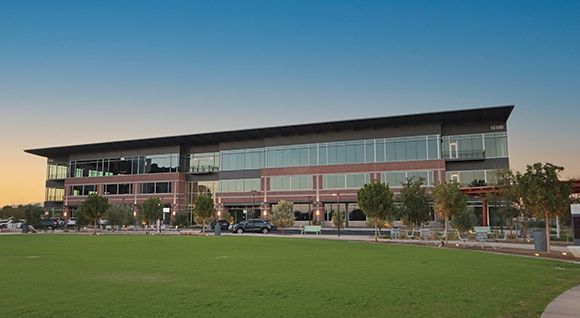|



|
FROM SITE SELECTION
MAGAZINE, JANUARY 2023 ISSUE
|

|
WESTERN CANADA
Fintech is one of several tech subsectors expanding in Calgary,
Vancouver and beyond.
|
|

|
INVESTMENT PROFILE: SARATOGA COUNTY, NEW YORK
As a semiconductor revolution takes place in the United States, New York
has captured two recent blockbuster projects, based in part on
longstanding industry support in the Capital Region.
|
|
 
|
Clean Energy Investment by Region, 2014-2022

|
Graph courtesy of IEA
|
|
The International Energy Agency has released “Energy Technology Perspectives 2023,” a 464-page
report about “the dawn of a new industrial age — the age of clean energy
technology manufacturing.” The IEA says the global market “for key
mass-manufactured clean energy technologies will be worth around US$650
billion a year by 2030 — more than three times today’s level — if
countries worldwide fully implement their announced energy and climate
pledges. The related clean energy manufacturing jobs would more than
double from 6 million today to nearly 14 million by 2030.” For
technologies like solar panels, wind, EV batteries, electrolyzers and
heat pumps, says the report, “the three largest producer countries
account for at least 70% of manufacturing capacity for each technology —
with China dominant in all of them. Meanwhile, a great deal of the
mining for critical minerals is concentrated in a small number of
countries. For example, the Democratic Republic of Congo produces over
70% of the world’s cobalt, and just three countries – Australia, Chile
and China – account for more than 90% of global lithium production.”
A concurrent report released 10 days ago places
China’s leadership in the context of the United States’ lack thereof.
“China has surpassed the United States in total innovation output and is
getting close on a proportional basis,” says the Information Technology
and Innovation Foundation (ITIF), a D.C.-based science and technology
policy think tank, in its new study, which finds that China’s innovation
and advanced-industry output in 2020 was 139% of the equivalent output
in the United States, up from 78% in 2010. Supported by a phalanx of
graphs and charts, the report delves into patents, degrees and
researcher employment, among other factors, to back its thesis.
“China has already shown itself capable of leading the world in several
advanced technologies, such as supercomputers and high-speed rail,” says
ITIF President Robert D. Atkinson, co-author of the report, using such
terms as “threaten,” “allied nations” and “security” to buttress the
urgency of ITIF’s perspective, which takes into account a wider
definition of innovation. “Simply assessing advanced-industry strength
by counting the number of science-based, new-to-the-world products a
country has developed is too narrow,” said ITIF policy analyst Ian Clay.
“There should be no call for complacency, given China’s recent gains in
areas such as space exploration, genomics, artificial intelligence, and
quantum computing.”
“The key question for U.S. policymakers is not whether China will
continue to make progress in innovation and advanced production,” says
Atkinson. “It clearly will. But how China performs relative to the
United States will largely depend on U.S. actions — so the question is
whether America will make this a central organizing principle for its
economic and technology policy.” – Adam Bruns
|
|

|
Education Technology
Backers of a new online game initiative in South Carolina see the
opportunity to alter young people’s career trajectories in life sciences
and beyond.
|
|
 
|

|
GSQ introduces a modern, forward-thinking destination. GEN 1 at GSQ, a
premier class A office building, is surrounded by a four-level parking
structure, two-acre civic park, Goodyear City Hall and Georgia T. Lord
Library. This exceptional location can absorb both new-to-market and
expansion of existing industry clusters in finance, insurance, and
technology. The 103,629 square-foot upscale office space features:
- Concrete Construction
- Three Floors, Three Stairwells, Two Elevators
- Partial Floor to Ceiling Glass
- ±15’ to ±18’ Floor to Deck Ceilings, ±10’ Finished Ceilings
- 5/1000 SF Parking Ratio in adjacent Multi-Level Parking Structure
- Building and Monument Signage available
- Convenient Access to Highways with three Full Diamond Interchanges
nearby
- Scenic Mountain Views
- Growing shopping, dining, and entertainment district
For more information, visit: https://www.developgoodyearaz.com/industries/office/gsq
|
|
|
SITE SELECTION
RECOMMENDS
|
|
In January, the Volcker Alliance, in partnership with the
Milken Institute, National Academy for Public
Administration, Penn Institute for Urban Research, and Pew
Charitable Trusts, convened congressional and executive
branch leaders, economists, and academics in Washington DC
for the Richard Ravitch Public Finance
Initiative Symposium. “Participants discussed
pressing state and local finance risks, and explored
feasible, federally-driven policy solutions,” says the
Alliance, with the event marking the official launch of the
Richard
Ravitch Public Finance Initiative, which seeks to
“catalyze federal action to improve state and local budget
practices that present looming risks to the federal system
and economy.”
A Volcker Alliance release explains that Ravitch, a Volcker
director and former lieutenant governor of New York State,
“is credited with guiding New York City out of its 1970s
fiscal crisis. In the 2010s, he advised the judge in
Detroit’s bankruptcy and the U.S. Treasury during Puerto
Rico’s bankruptcy.” In a discussion at a dinner kicking off
the symposium, Ravitch said, “Members of Congress have an
appalling ignorance of state and city budgets.” Even after
the crises in Detroit and Puerto Rico, Ravitch said, “many
cities and states continue to budget in an irresponsible
manner.”
|
|
|
|
KANSAS — THE STATE OF
UNEXPECTED
|

|
TOURISM
Here’s how Kansas is turning tourism into economic development.
|
|
Utah
In 2022 Electric Power Systems announced this massive investment in
rural Utah supported by a temporary, marginal tax reduction for its
expansion awarded by the Utah Governor’s Office of Economic Opportunity
(Go Utah) as part of the Legislature’s Economic Development Tax
Increment Financing (EDTIF) program. EP Systems, a provider of
“high-voltage, high-power, certifiable, and scalable power systems for
high-reliability applications in the aviation industry,” plans to bring
up to 3,130 high-paying jobs and invest significant capital at the site
in Cache County over the next nine years. The company’s battery
solutions are also applicable in the automotive, marine and industrial
traction sectors. Investors in EP Systems have included Boeing and
Safran in 2019 and in 2021, with JetBlue stepping up in 2022. The
company is currently partnered with the FAA to certify batteries for
general aviation aircraft “and will complete its first TSO [technical
standard orders, a minimum performance standard] in early 2023,” EP
Systems says.
Pennsylvania
Last June The Hershey Company cut the ribbon for a new 800,000-sq.-ft.
fulfillment center and the first fully digitally enabled facility with
real-time reporting on a 213-acre site in Annville, Pennsylvania,
located just outside of Hershey. “The bulk of the Design-Build Annville
Fulfillment Center’s square footage (783,200 sq. ft.) is dedicated to
processing and storage operations,” explains The Korte Co., Hershey’s
construction partner. Offices comprise the remaining 36,000 sq. ft.
“Because of the ambient sensitivity of chocolate, processing and storage
areas are designed to maintain a constant temperature of 60 degrees and
a maximum relative humidity of 50%,” the builder explains. The project
is part of an approved $1 billion investment in the company’s supply
chain network that in November 2022 took the form of another new
facility, measuring 250,000 sq. ft., for producing chocolate on a
55-acre site near the company’s Reese’s plant in Hershey proper. The
overall investment also includes the addition of 13 production lines and
the upgrading of 11 existing lines in other North American facilities.
|
|

|
Photo by Kholik Olie courtesy of GCCA
|
|
The Global Cement and Concrete Association (GCCA) this week unveiled its
short list of 80 photos from around the world in
the “Concrete in Life” photography competition. If that doesn’t seem so
short, consider that 14,000 photos were submitted from every major
continent by both amateur and professional photographers. Which adds
ballast to the GCCA’s statement that concrete is the second most-used
substance on earth after water. All 80 images now have a chance to claim
the $10,000 prize for the overall winner and $2,500 for each of eight
category winners, all of whom will be announced February 15th. This
image made by Kholik Olie in the “Urban Concrete – Professional”
category captures a skateboarder in action in Jakarta, Indonesia.
|
| |

